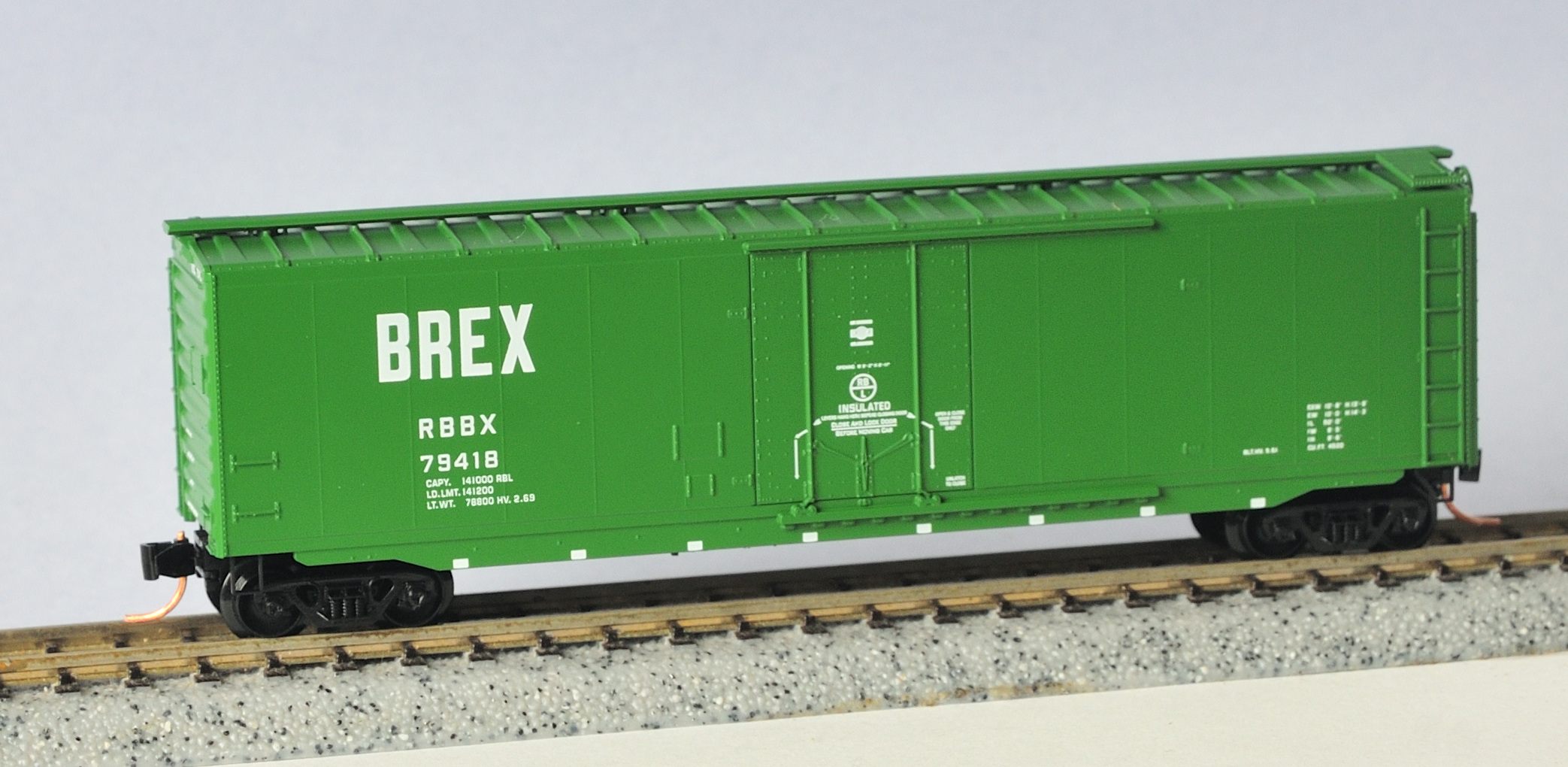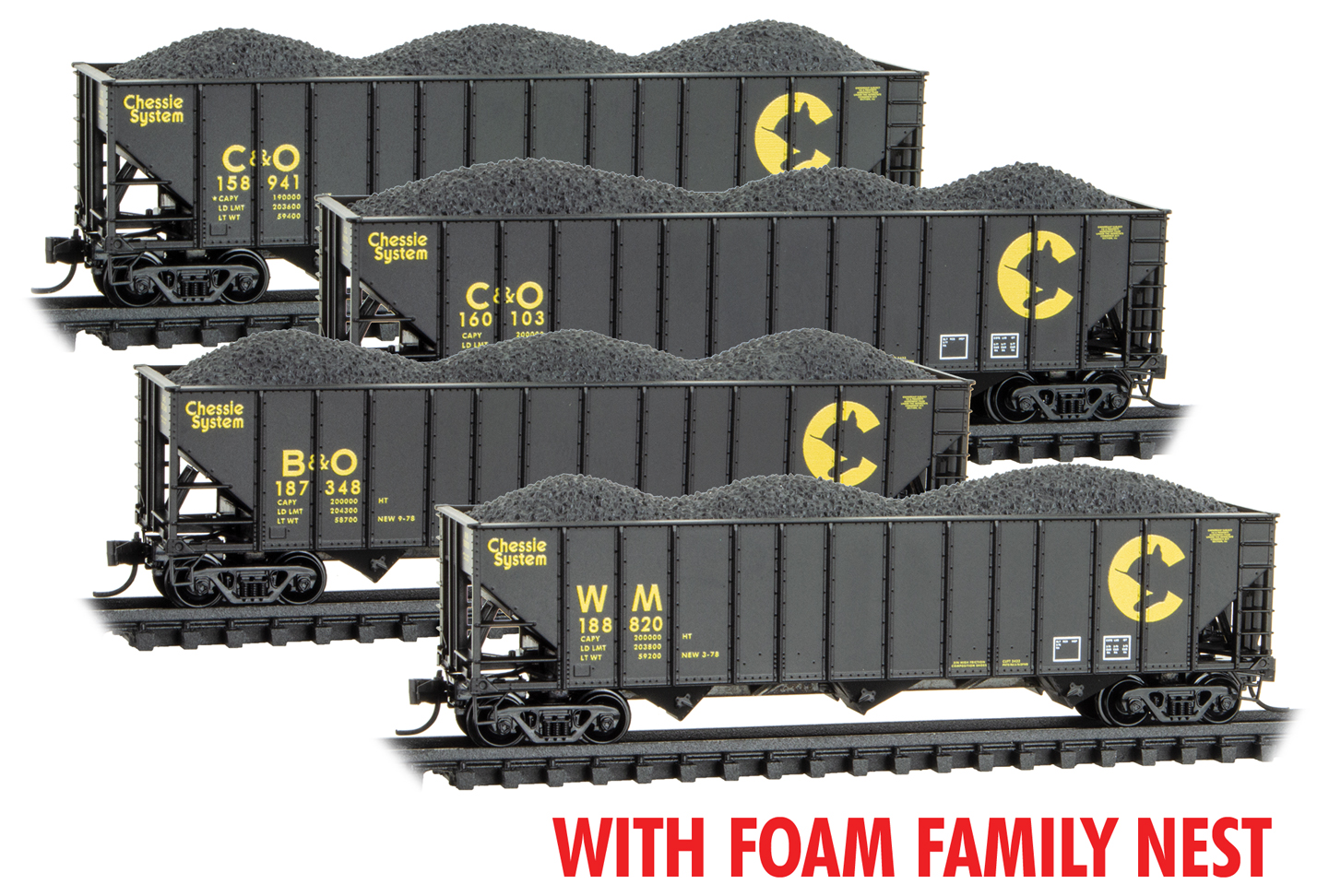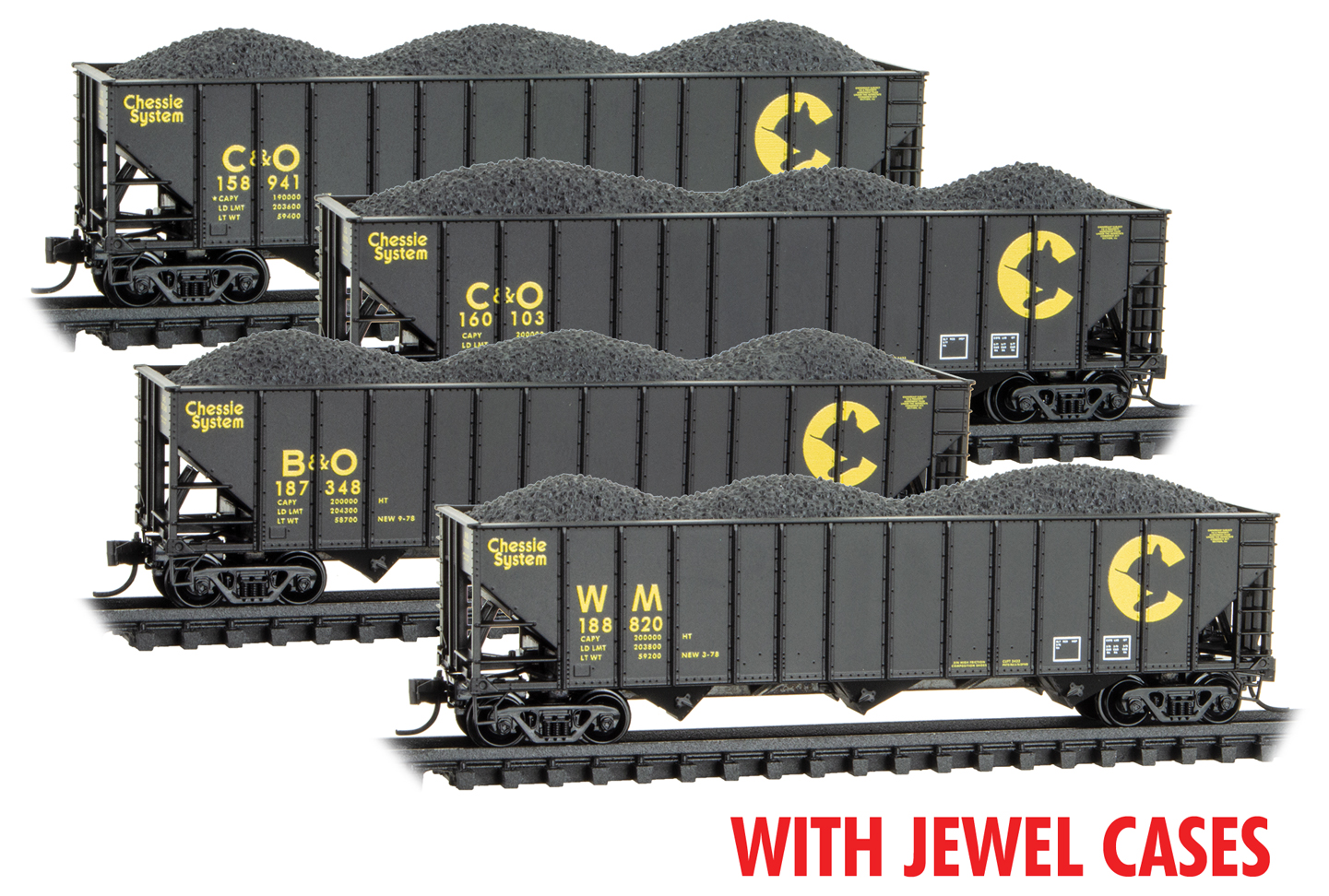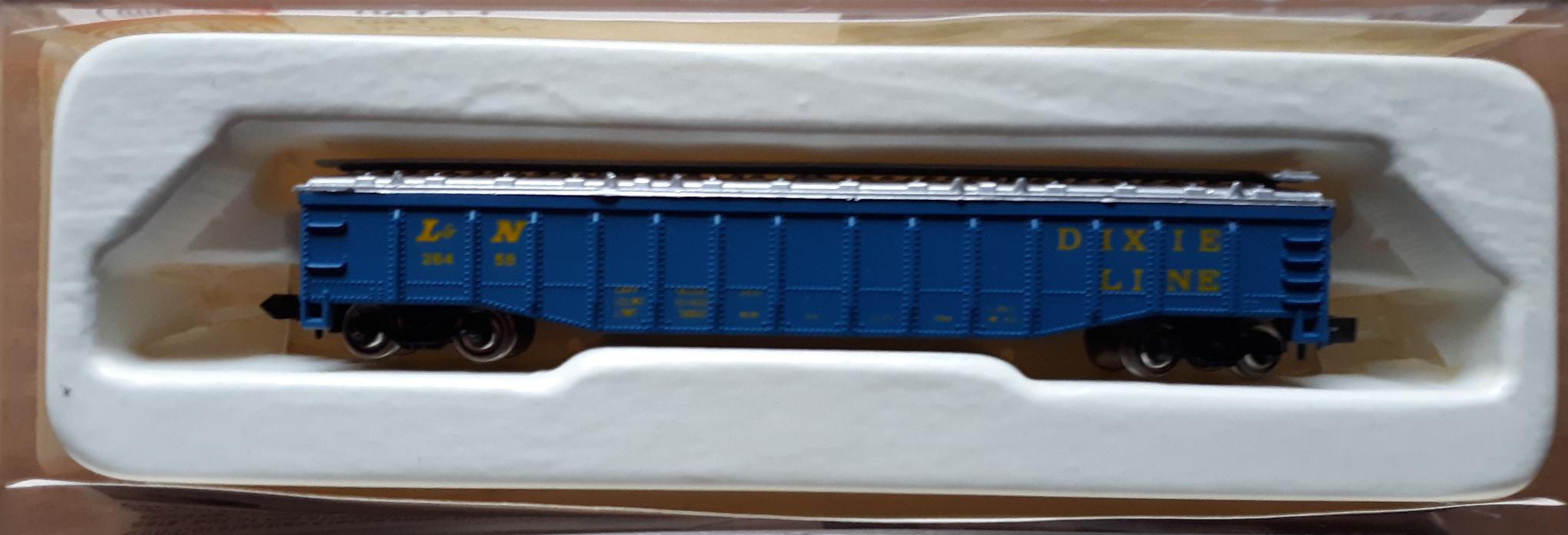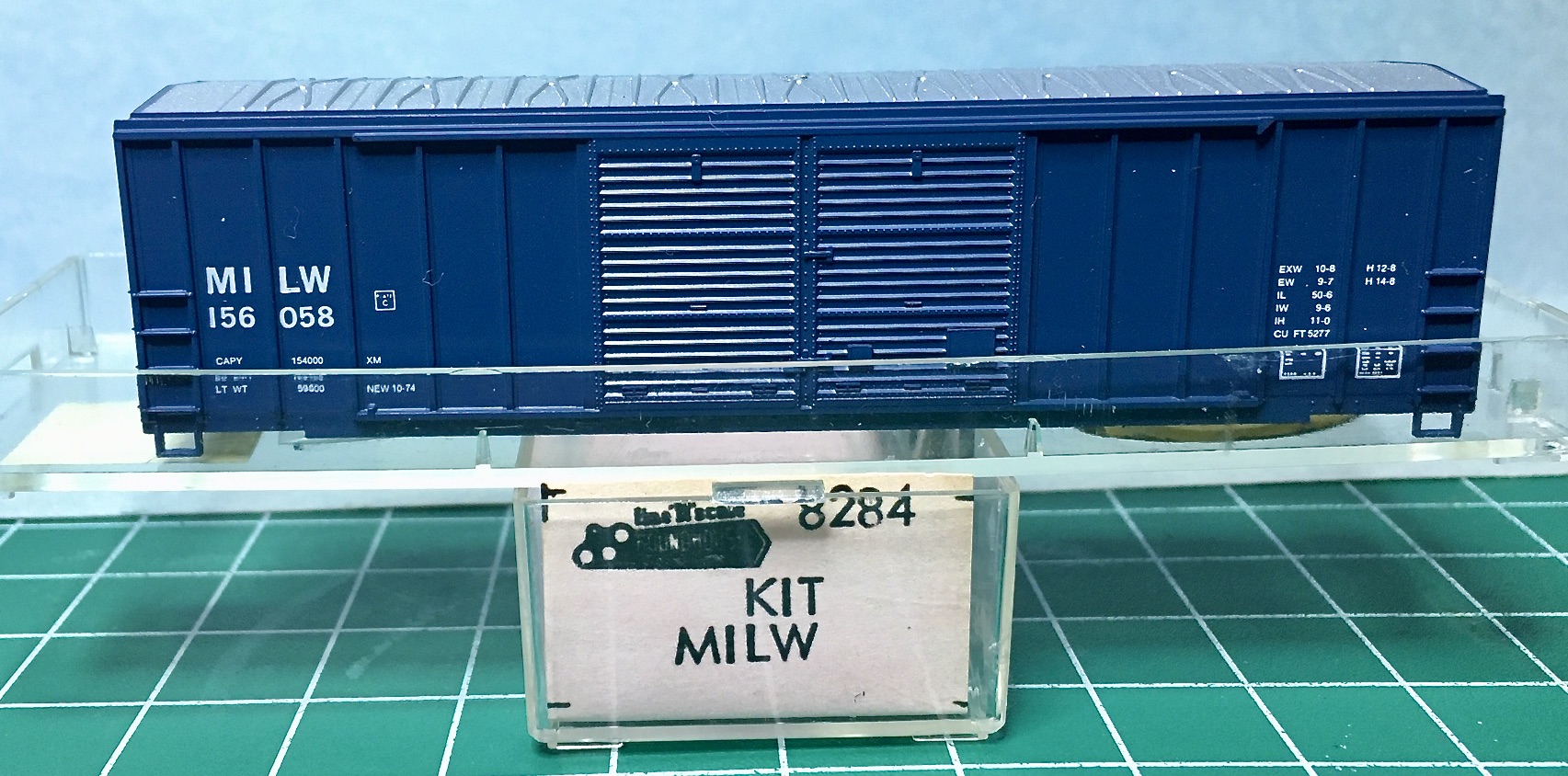Model Information: Boxcar, 50 Foot, Offset Double Sliding Door, Rib Side, Without Roofwalk, FMC. Originally designed by MDC Roundhouse, this tooling was acquired by Athearn in June of 2004. It has since been re-released with Accumate and/or McHenry couplers. This body style has two doors offset from center of the car.
Current versions features: Scale profile brake wheel; Roller bearing trucks; Fully-assembled and ready-to-run out of the box; Accurately painted and printed; Highly detailed, injection molded body; Machined metal wheels; Screw mounted trucks; McHenry knuckle couplers; Weighted for trouble free operation; Clear plastic jewel box for convenient storage; Operates on Code 55 and 80 rail; Minimum radius: 9-3/4".
Current versions features: Scale profile brake wheel; Roller bearing trucks; Fully-assembled and ready-to-run out of the box; Accurately painted and printed; Highly detailed, injection molded body; Machined metal wheels; Screw mounted trucks; McHenry knuckle couplers; Weighted for trouble free operation; Clear plastic jewel box for convenient storage; Operates on Code 55 and 80 rail; Minimum radius: 9-3/4".
Prototype History: In the 1970's with the growth of the Per Diem business model, FMC produced a series of 50 foot box cars in different configurations. The single-sliding-door configuration is one of the best known and used widely by many different railroads. These cars were produced using the Gunderson metal works which FMC had acquired in 1965. In late 1975, FMC began producing a 5,077-cubic-foot Plate B box car for IPD and Railbox service. FMC's 5077s have seven panels to either side of the 10-foot door, an X-panel roof, and non-terminating ends that are slightly different from those used on FMC's earlier cars. Note how the sidesill is notched all the way back to the bolsters, a key feature of FMC's mature design.
The main difference between the 5077 cu. ft cars built by FMC vs the 5277-5347 cu. ft cars built by the same manufacturers is the overall height of the car, the smaller 5077 cars were Plate B while the larger 5277-5347 cars were Plate C. Over 4,300 cars were produced from 1975-1979 by FMC's Portland, Oregon plant. The cars were delivered in numerous colorful shortline paint schemes, as well as the nationwide car pool fleet of Railbox. Many secondhand cars were later seen in Class 1 railroads and large leasing company fleets under additional shortline reporting marks.
The main difference between the 5077 cu. ft cars built by FMC vs the 5277-5347 cu. ft cars built by the same manufacturers is the overall height of the car, the smaller 5077 cars were Plate B while the larger 5277-5347 cars were Plate C. Over 4,300 cars were produced from 1975-1979 by FMC's Portland, Oregon plant. The cars were delivered in numerous colorful shortline paint schemes, as well as the nationwide car pool fleet of Railbox. Many secondhand cars were later seen in Class 1 railroads and large leasing company fleets under additional shortline reporting marks.
Road Name History: The 96 miles of track across the top of Vermont has been operated by a number of railroads throughout its history. Up until 1925 it was part of the Boston & Maine. Then it operated as the St. Johnsbury and Lake Champlain. Bankruptcy in 1944 led to a reorganization and a name change to the St. Johnsbury and Lamoille County. Orange and cream GE 70 tonners plied the rails until 1967, when Samuel Pinsley purchased the line on the verge of abandonment. Pinsley family red GP9s and RS3s operated the deteriorating railroad until 1972.
The Lamoille Valley Railroad Company took over operations from the Vermont Northern starting January 1, 1978. The LVRC was given a 10 year lease from the State of Vermont and the money to rebuild the entire 96 mile rail line. In addition, operating subsidies were provided in an effort get the line up and running. Motive power again came from the Delaware & Hudson. Four RS3s were repainted into a yellow with green stripe and lettering scheme. In addition, 100 50' IPD boxcars were leased, painted into the same yellow and green scheme, assuring cars for local shippers.
In 1989, when the B&M (Guilford) sold off its lines in northern New Hampshire (Woodsville to Berlin and Groveton), this trackage plus the Twin State RR and LVRC were acquired by CSF Acquisitions and the entire operation became the New Hampshire & Vermont Railroad. The LVRC ceased as a separate railroad entity, although the line west of St. Johnsbury still retained this name and passenger excursions continued for a few more years. No freight customers existed west of St. J.
Finally the axe fell on the line when the Vermont legislature granted authority to turn the eastern end, Morrisville to St. J, into a snow trail. All rail and ties were pulled up. Fisher Bridge will remain in place. The western section, Morrisville to Sheldon, will be left as is in hopes of restoring rail service and supporting business and the local economy.
From The Northeast Kingdom Railroad
The Lamoille Valley Railroad Company took over operations from the Vermont Northern starting January 1, 1978. The LVRC was given a 10 year lease from the State of Vermont and the money to rebuild the entire 96 mile rail line. In addition, operating subsidies were provided in an effort get the line up and running. Motive power again came from the Delaware & Hudson. Four RS3s were repainted into a yellow with green stripe and lettering scheme. In addition, 100 50' IPD boxcars were leased, painted into the same yellow and green scheme, assuring cars for local shippers.
In 1989, when the B&M (Guilford) sold off its lines in northern New Hampshire (Woodsville to Berlin and Groveton), this trackage plus the Twin State RR and LVRC were acquired by CSF Acquisitions and the entire operation became the New Hampshire & Vermont Railroad. The LVRC ceased as a separate railroad entity, although the line west of St. Johnsbury still retained this name and passenger excursions continued for a few more years. No freight customers existed west of St. J.
Finally the axe fell on the line when the Vermont legislature granted authority to turn the eastern end, Morrisville to St. J, into a snow trail. All rail and ties were pulled up. Fisher Bridge will remain in place. The western section, Morrisville to Sheldon, will be left as is in hopes of restoring rail service and supporting business and the local economy.
From The Northeast Kingdom Railroad
Brand/Importer Information: Athearn's history began in 1938, when its founder-to-be, Irvin Athearn, started an elaborate O scale layout in his mother's house. After placing an ad selling the layout, and receiving much response to it, Irv decided that selling model railroads would be a good living. He sold train products out of his mother's house through most of the 1940s. After becoming a full-time retailer in 1946, Irv opened a separate facility in Hawthorne, California in 1948, and that same year he branched into HO scale models for the first time.
Athearn acquired the Globe Models product line and improved upon it, introducing a comprehensive array of locomotive, passenger and freight car models. Improvements included all-wheel drive and electrical contact. One innovation was the "Hi-Fi" drive mechanism, employing small rubber bands to transfer motion from the motor spindle to the axles. Another was the double-ended ring magnet motor, which permitted easy connection to all-wheel-drive assemblies. Athearn was also able to incorporate flywheels into double-ended drives.
The company produced a model of the Boston & Maine P4 class Pacific steam locomotive which incorporated a cast zinc alloy base and thermoplastic resin superstructure. It had a worm drive and all power pickup was through the bipolar trucks that carried the tender. This item was discontinued after the Wilson motor was no longer available, and was not redesigned for a more technologically advanced motor.
Athearn's car fleet included shorter-than-scale interpretations of passenger cars of Southern Pacific and Atchison, Topeka & Santa Fe Railroad prototypes. The company also offered a variety of scale-length freight cars with sprung and equalized trucks. The cars could be obtained in simple kit form, or ready-to-run in windowed display boxes. The comprehensive scope of the product line contributed to the popularity of HO as a model railroad scale, due to the ready availability of items and their low cost.
Irv Athearn died in 1991. New owners took control in 1994, but continued to follow Athearn's commitment to high-quality products at reasonable prices. Athearn was bought in 2004 by Horizon Hobby. Athearn was then moved from its facility in Compton to a new facility in Carson, California. In mid-2009, all remaining US production was moved to China and warehousing moved to parent Horizon Hobby. Sales and product development was relocated to a smaller facility in Long Beach, California.
Read more on Wikipedia and Athearn website.
Athearn acquired the Globe Models product line and improved upon it, introducing a comprehensive array of locomotive, passenger and freight car models. Improvements included all-wheel drive and electrical contact. One innovation was the "Hi-Fi" drive mechanism, employing small rubber bands to transfer motion from the motor spindle to the axles. Another was the double-ended ring magnet motor, which permitted easy connection to all-wheel-drive assemblies. Athearn was also able to incorporate flywheels into double-ended drives.
The company produced a model of the Boston & Maine P4 class Pacific steam locomotive which incorporated a cast zinc alloy base and thermoplastic resin superstructure. It had a worm drive and all power pickup was through the bipolar trucks that carried the tender. This item was discontinued after the Wilson motor was no longer available, and was not redesigned for a more technologically advanced motor.
Athearn's car fleet included shorter-than-scale interpretations of passenger cars of Southern Pacific and Atchison, Topeka & Santa Fe Railroad prototypes. The company also offered a variety of scale-length freight cars with sprung and equalized trucks. The cars could be obtained in simple kit form, or ready-to-run in windowed display boxes. The comprehensive scope of the product line contributed to the popularity of HO as a model railroad scale, due to the ready availability of items and their low cost.
Irv Athearn died in 1991. New owners took control in 1994, but continued to follow Athearn's commitment to high-quality products at reasonable prices. Athearn was bought in 2004 by Horizon Hobby. Athearn was then moved from its facility in Compton to a new facility in Carson, California. In mid-2009, all remaining US production was moved to China and warehousing moved to parent Horizon Hobby. Sales and product development was relocated to a smaller facility in Long Beach, California.
Read more on Wikipedia and Athearn website.
Item created by: CNW400 on 2023-12-29 15:02:53. Last edited by baggedbird on 2024-08-02 16:34:31
If you see errors or missing data in this entry, please feel free to log in and edit it. Anyone with a Gmail account can log in instantly.
If you see errors or missing data in this entry, please feel free to log in and edit it. Anyone with a Gmail account can log in instantly.






